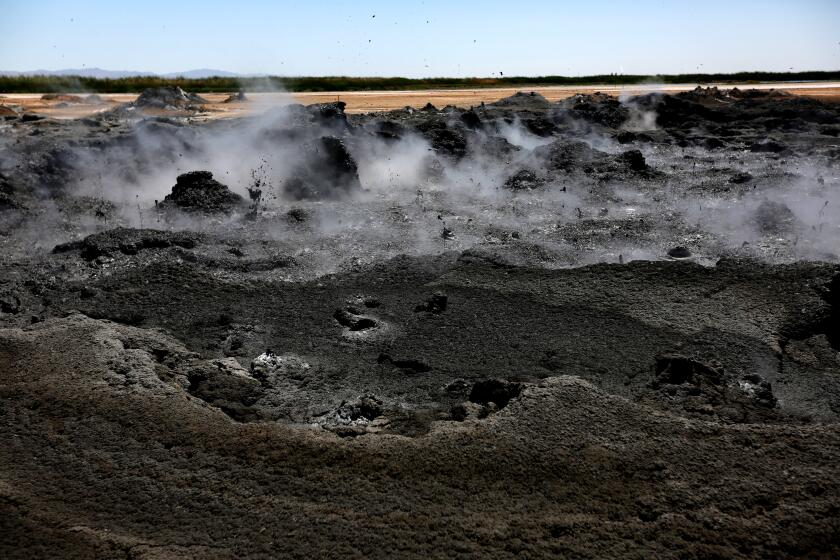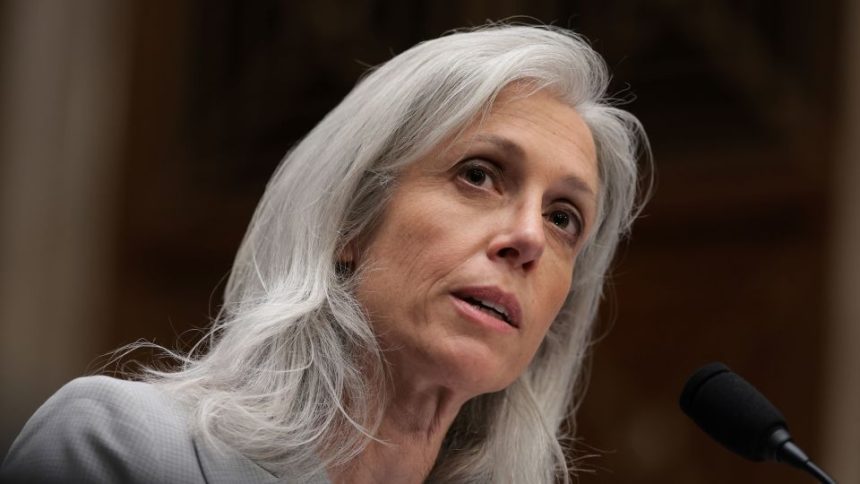For the first time in nearly a decade, federal officials on Tuesday auctioned off leases for new geothermal energy projects in California — and all 13 parcels offered received bids.
Dozens of buyers participated in the Bureau of Land Management’s online sale of 10-year leases on 23,000 acres in Imperial, Lassen and Modoc counties. Geothermal is a growing source of energy that can produce clean electricity 24 hours a day, unlike wind and solar power.
Typically the technology involves drilling wells into pockets of steam and hot water rising from the center of the Earth, which then spin turbines to generate power.
Many experts see an expanded role for geothermal in addressing climate change, and say it could be key in meeting California’s clean energy goals, including reaching carbon neutrality by 2045. California is already home to the world’s largest geothermal field — the Geysers in Sonoma and Lake counties — as well as a major field in the Salton Sea area.
Tuesday’s winning bids ranged from $2 to $247 an acre. Twelve of the parcels are in Imperial County, with most in the Salton Sea Basin, though not the Salton Sea itself. The 13th parcel, a 240-acre tract bridging Modoc and Lassen counties, sold for $2 an acre.
The bidders are banking on the idea that new tools and technology will help them harness more of Earth’s natural heat as a source of electricity.
“There’s a lot of excitement around geothermal,” said Eric Gimon, a senior fellow with the nonpartisan think tank Energy Innovation.
Read more: Column: Good news for 100% clean energy. Geothermal has finally arrived
Until recently, only certain areas were thought to have geothermal potential. In the U.S., the most favorable are in the western half of the country, where some of the most promising sites such as the Geysers have already been tapped.
But new technology known as Enhanced Geothermal Systems is broadening the places where geothermal energy can be created — removing the sense of a fishing expedition for developers hoping their wells will hit a hot spot. Instead of searching for existing sources of hot subsurface water, they can create their own reservoirs by fracturing dry rocks underground and injecting them with water from above.
This is reducing some of the financial risk, making geothermal more attractive, Gimon said. He was not surprised that most of the interest in Tuesday’s auction was in the Imperial Valley, which is easier to access and closer to transmission lines than volcanic sites in Northern California. The top-selling tract was a 2,520-acre parcel east of Brawley in Imperial County, which sold for $247 an acre. The auction service does not name the bidders.
The energy picture continues to change, but geothermal is currently more expensive than some other sources, averaging around $40 to $80 per megawatt hour, compared with about $20 to $30 for solar. However, Gimon noted that costs are becoming more competitive as the technology improves. Google and Microsoft have shown keen interest in powering artificial intelligence data centers with geothermal, and are willing to pay steeper prices.
“I’m very bullish on geothermal with this new set of technologies,” Gimon said. “I think it could be a really important part of the mix.”
Geothermal currently represents only a small fraction of energy supplies in the country — about 0.4% of total U.S. utility-scale electricity generation, according to the U.S. Energy Information Administration. But new techniques could increase that share to as much as 8.5% by 2050.
Read more: Interior Secretary Burgum eyes national monuments for energy resources
Geothermal has also found found favor with the Trump administration, which has otherwise taken a hard stance against renewable energy, including wind and solar. Trump — who raised record donations from fossil fuel companies during his 2024 presidential campaign — named geothermal energy as a priority when he declared a national energy emergency in January.
In recent months, the administration has called for opening up public lands for energy resource extraction, including oil drilling, coal mining, timber production and geothermal exploration. U.S. Energy Secretary Chris Wright is an investor in Fervo Energy, one of the nation’s leading enhanced geothermal companies, which announced a milestone agreement to sell power to Southern California Edison in 2024.
Geothermal is not without downsides, however. The process has been known to trigger seismic activity, including a magnitude 5.5 earthquake in South Korea in 2017. Small temblors are also common around the Geysers geothermal steam field in California.
Since it is a drilling technology, fossil fuel companies have shown interest in using their experience in the growing sector.
Many environmental groups are also supportive of geothermal to address climate change.
“It is nearly impossible to understand the magnitude of how big this market has expanded,” said Terra Rogers, director of the superhot rock geothermal program at the nonprofit Clean Air Task Force, who recently co-wrote a report about geothermal expansion in California.
“What changed was the technique to not have to hunt-and-peck for hot water,” Rogers said. “What’s working against us is that now we have to get the word out. We have to communicate that geothermal now belongs in nearly everybody’s portfolio, and certainly California’s, because California has an incredible resource of heat.”
Ashley Arax, senior California policy manager at the Clean Air Task Force and another of the report’s authors, said the state can take full advantage of its geothermal potential by creating a long-term plan for this energy; streamlining permitting; modernizing regulations to keep pace with new technology and speeding up connection to the grid.
As the goal of eliminating the gases that cause climate change by 2045 approaches, she said, and natural gas plants are decommissioned, “next-gen geothermal can be, we think, a major player,” Arax said.
Read more: What’s behind the more than 130 small earthquakes hitting Northern California?
California is supportive of the sector, with the California Public Utilities Commission calling for the state to procure up to 1 gigawatt of geothermal power by 2037. The state is already the top geothermal producer in the nation — with 66% of the country’s total geothermal electricity generation in 2023, the most recent year for which data were available, according to the Energy Information Administration.
The parcels auctioned by the Bureau of Land Management were either selected by the agency or nominated for selection by interested parties. The 10-year leases may be extended “if the lessee establishes production or provides proof of diligent exploration,” the BLM said.
Buyers must comply with National Environmental Policy Act, or NEPA, reviews — although Trump in recent weeks has moved to substantially weaken those regulations.
Tuesday’s sale generated about $2.75 million. Half will go to the state of California, 25% to the county where the lease is located, and 25% to the U.S. Treasury, according to the BLM.
This story originally appeared in Los Angeles Times.













